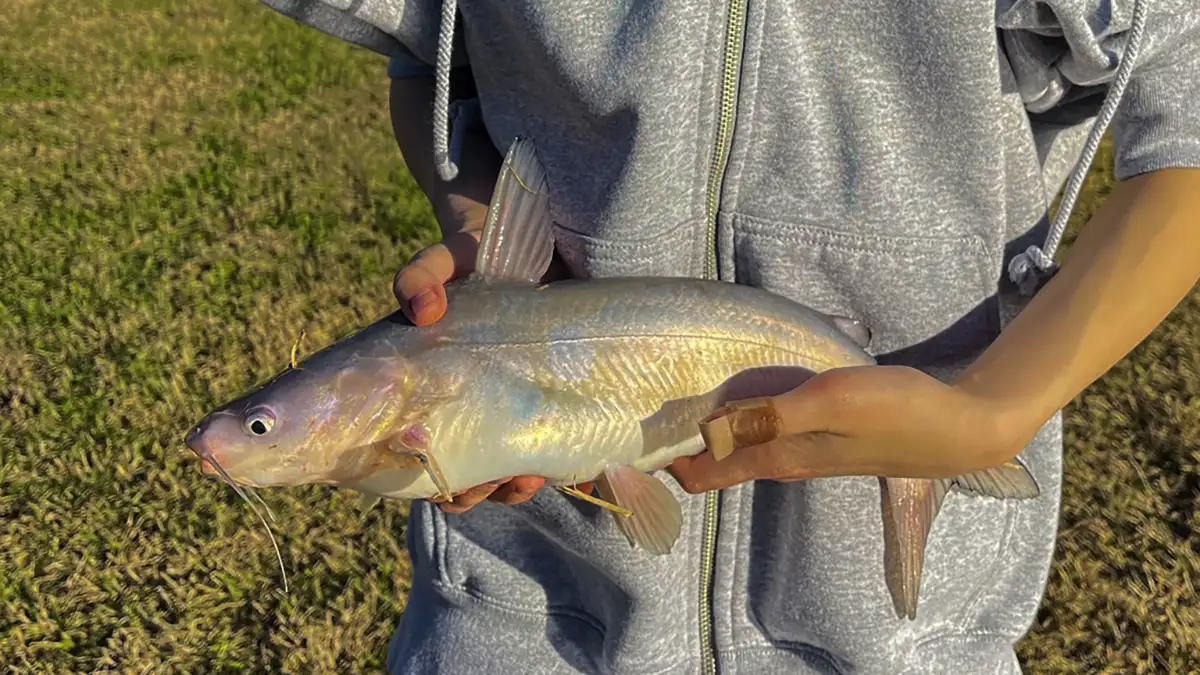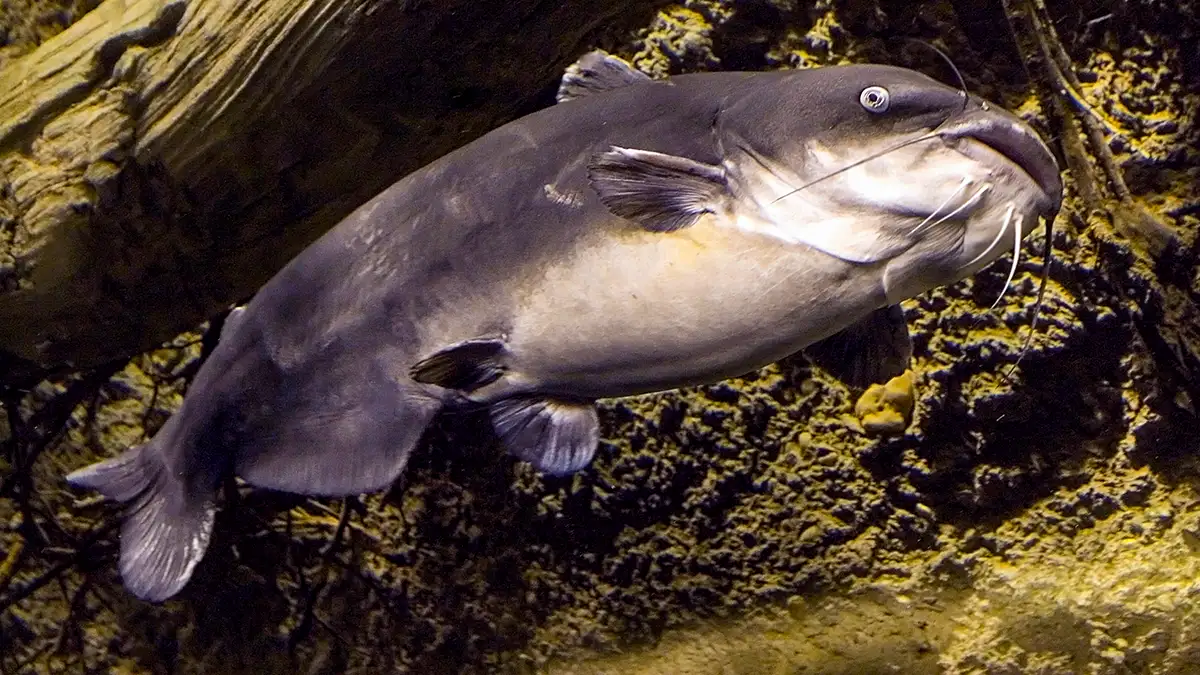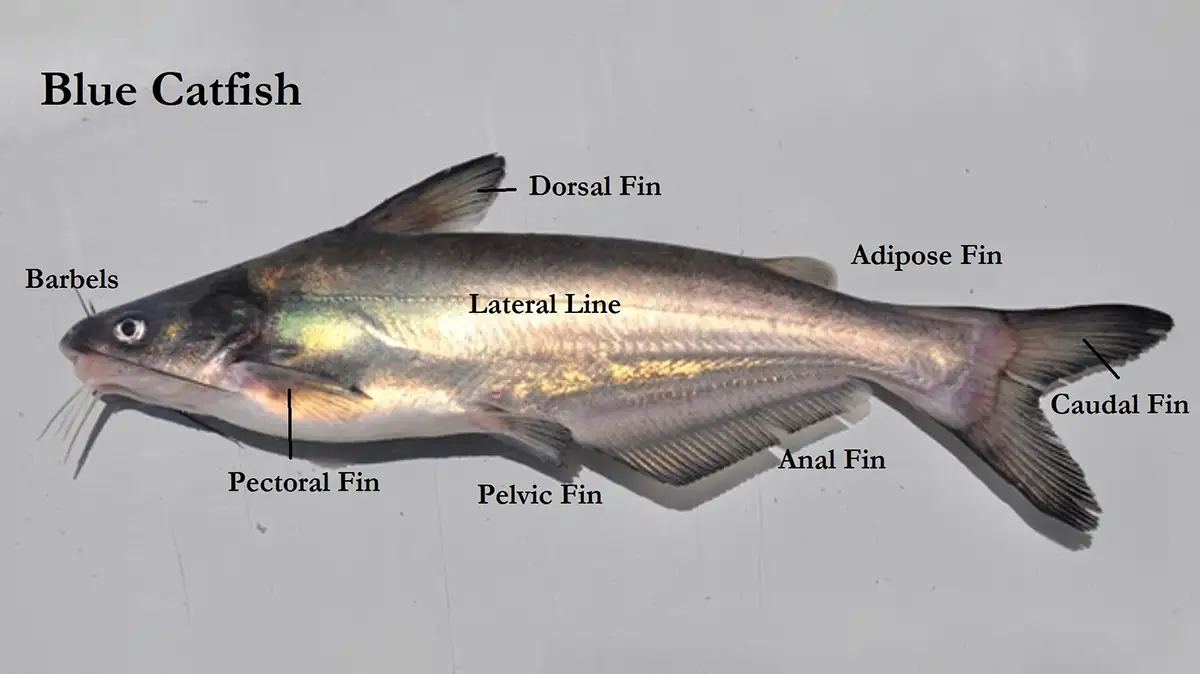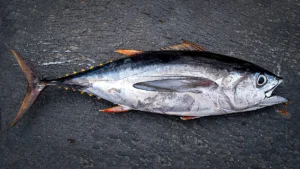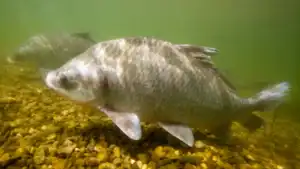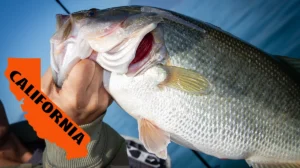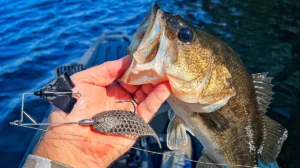The blue catfish haunt the dreams of anglers who have heard stories or read accounts of fish growing to be the size of cars and weighing up to 300 pounds in the 1800s. American author Mark Twain is said to have seen blue catfish on the Mississippi River close to 6 feet long and nearly 250 pounds. If this sounds interesting, just wait to see what else we have for you in this species profile of blue catfish. And once you’ve learned how to catch catfish, this is the species you will graduate to when you want to start catching the real trophy catfish.
Blue Catfish History
Blue Catfish (Ictalurus furcatus) belong to the Ictaluridae family, which includes channel catfish, white catfish, bullheads, and the flathead catfish. The Ictaluridae family contains fifty-one species and is North America’s most prominent fish family. There are other families of catfish worldwide, including the Pangasiidae which includes the Mekong giant catfish, the Siluridae, which includes the wels catfish, Callichthyidae which includes the aquarium cory catfish, and the Loricariidae which includes the armored catfish. These families are found in Siluriformes order, which includes all catfish species found worldwide.
Blue catfish were first described by Achille Valenciennes in 1840. Valenciennes first wrote about blue catfish in “Historie Naturelle des Poissons” or Natural History of Fish while working at the French National Museum of Natural History. The species name Ictalurus punctatus is broken into two parts, Ictalurus is a combination of Greek words that translates to fish cat referring to the prominent whiskers or barbels on the face, and furcatus is Latin for forked which is in reference to the forked tail of the fish.
Alternative Names for Blue Catfish
The blue catfish has several common names, including white catfish, giant blues, humpback-blue, silver cat, blue cat, high-fin blue, chuckle-head, and fork-tailed cat.
Blue Catfish Identification
The blue catfish holds the title of the largest North American catfish species and therefore is an extremely popular sport fish. Identifying them compared to channel catfish can still be somewhat difficult for novice anglers as they have similar appearances until you know a few key features to look for.
Like other catfish species, the blue catfish has smooth scaleless skin, with soft barbels around the mouth. These barbels contain no spines and are harmless sense organs used primarily for locating food. The four barbels above the mouth are dark in coloration and the ones below the mouth are lighter white to gray in coloration. The mouth on the blue catfish is slightly sub terminal, large for its body size, and has hundreds of small cardiform teeth. These teeth are packed in dense rows and result in an abrasive coarse sandpaper like feel.
The head of the blue catfish is round with small eyes located more forward on the head compared to channel catfish. Some blue catfish will have a slight body hump located just behind the head where the dorsal fin sits. The dorsal and pectoral spines will have well developed serrations that become more dull with age. Behind the dorsal fin sits a fat filled fin called an adipose-fin. It is rounded and flexible at the tip. The caudal fin or tail fin is deeply forked. Channel catfish have similar dorsal, pectoral, adipose, and caudal fin characteristics.
The most notable difference between the blue catfish and channel catfish fins is at the anal fin. Blue catfish anal fins will have a straight edge versus a rounded edge found on the channel catfish. The anal fin will also be longer with more rays than the channel catfish. Fin counts should be 30-36 anal soft fin rays, 6-7 dorsal soft fin rays, and 8 pelvic soft fin rays.
Body coloration will generally be bluish to gray on the back and head moving lighter down the both to a white to gray belly region. The fins are light colored and will have dark margins. Blue catfish do not typically have black spotting on the body, which is a key characteristic of young channel catfish. There is some documentation of a group of blue catfish occurring specifically in the Rio Grande that has black spots covering the body, but once again this is rare.
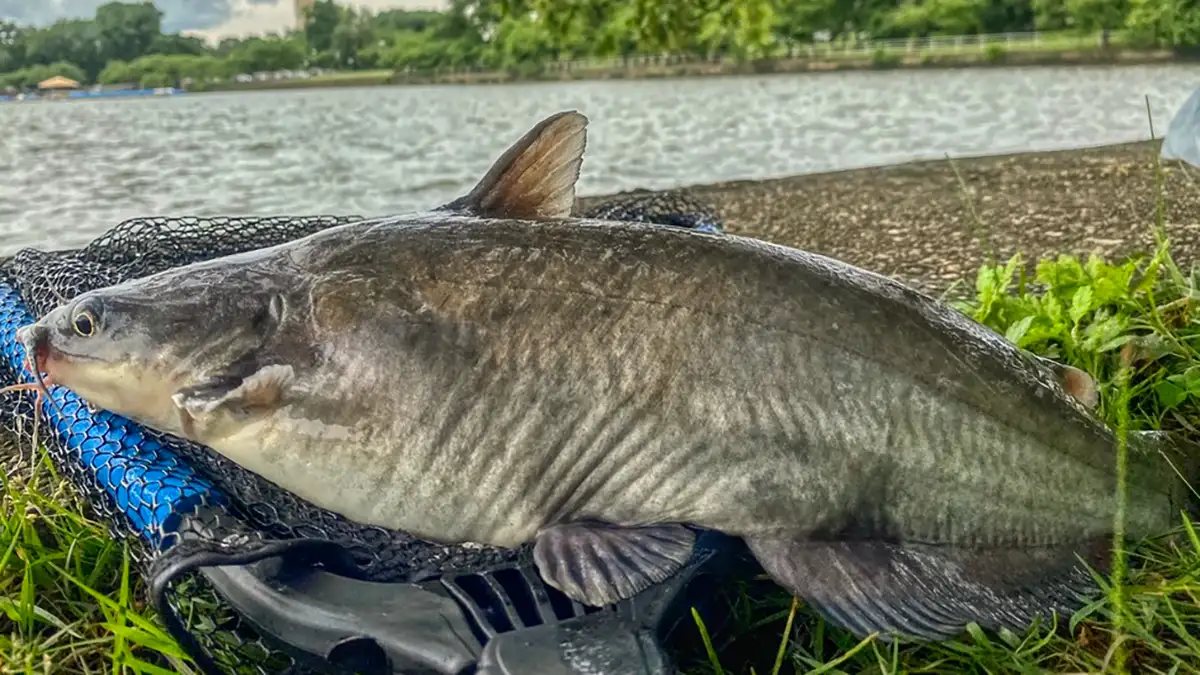
Blue Catfish Location
The blue catfish is found to be native primarily to the southern reaches of the Mississippi, Missouri, Ohio and Rio Grande river basins. This home range likely included a northern boundary in southern Pennsylvania expanding west to South Dakota down through south western Nebraska and continuing southward to the Gulf of Mexico. Populations were found throughout coastal Texas and into New Mexico. They continued out of the US into Mexico and northern Guatemala along the Gulf Coast. Blue catfish were exclusively found in rivers and coastal regions up until the early 1900s.
As a popular sportfish, a fierce predator and somewhat widely spread commercially stocked fish, blue catfish have expanded well beyond their native range. They can be found in all reaches of the continental US as well as all of Mexico and Guatemala.
For a better understanding of where blue catfish historically were found and where they are potentially located today we prepared this interactive map.
Blue Catfish Spawning
The blue catfish spawn is very similar to the channel catfish; the season starts in early summer with water temperatures ranging from 70 F and 77 F and peak spawning activity occurring between 75 F to 82 F. They are primarily cavity nest spawners. The male blue catfish will begin by finding a cavity just larger than his body under rock, in undercut banks, under root wads, in a barrel, or under fallen trees. The male will create a nest by doing continuous sweeping movements with his tail, this allows for removal of debris and exposes the hard bottom. These nests usually vary from 6-14 inches in diameter but will almost always be within a cavity.
Courtship will take place between the males and females with the use of cues including the males body coloration becoming darker, swimming patterns around the female, mild bitting, and rubbing his belly and barbels on her face. Females typically select one male per season to spawn with. She will lay around 2,000 to 4,000 eggs per pound of body weight. The eggs will be translucent and adhesive sticking to the substrate of the nest. Once eggs are fertilized the male will assume a primary guard role, protecting the eggs and resulting fry for weeks.
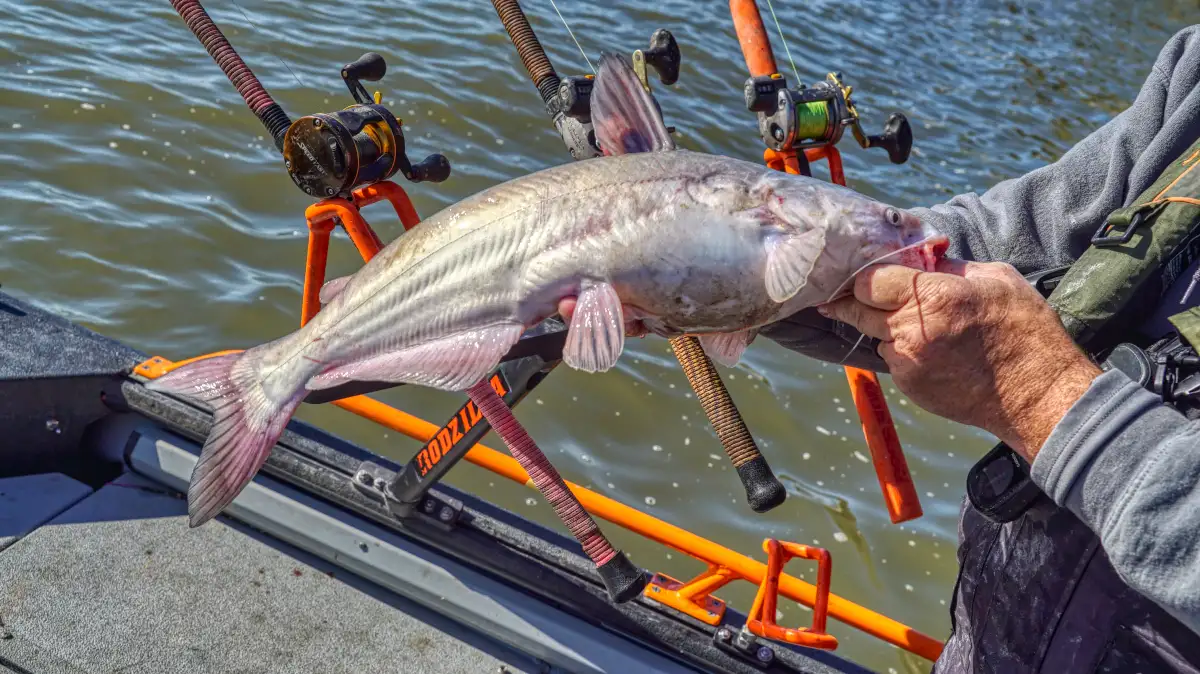
Blue Cat Size and Lifespan
Eggs within a nest will darken and turn yellow over one to two weeks. The eggs will ripen and hatch based primarily on water temperature and water flow. The flow is provided by the males pushing water over the eggs periodically. At 77 F the eggs hatch in around 10 days and this duration can be reduced to 6 days at 80 F. Upon hatching, fry are without pigment and non mobile. They will darken in color after 3 days and consume their yolk and swim up in 3 to 6 additional days.
Blue catfish grow and mature at a slower rate initially compared to channel catfish. Estimated growth rates of blue catfish show an average growth of just 3 to 6 inches in length their first year. They continue to grow at an average rate of 2 to 4 inches per year, speeding up as they increase in size over 12 inches. It takes at least 4 years for a male to become mature and 5 years for a female. This slow initial growth rate and delayed reproduction allow blue catfish to have extremely long lives with 10 to 15 years begin common and several fish over 20 years being observed.
Blues Habitat
Adult blue catfish need certain conditions to reach their large sizes. Typically these large fish will be found in rivers with quick currents or deep lakes with large amounts of open water. Blue catfish prefer areas where they can be secluded and will be found in deep channels or pools where they can wait for food. The preferred river substrate of these fish are hard bottoms that contain rip rap or large rocks.
Blue catfish can be found around gravel or sandy areas in lakes where hard substrate is limited. The temperature will dictate where blue catfish can be found in rivers and lakes. Blue catfish will move to warmer waters during the colder periods and cooler water in summer months. Blue catfish are typically found in freshwater but can thrive in brackish water as well.
Their salinity tolerance can be as high at 15 ppt, but for long term survival, they prefer salinity below 4 ppt.
Blue Cat Diet
Blue catfish will feed either in the early morning or later into the evening. Feeding behavior is dependent on the size of the blue cats. Smaller to medium-sized fish can be caught on shallow flats, and larger fish feed in deeper parts where the current brings them food. Blue cats will sometimes school up and feed in groups throughout the water column. If looking for an area to catch these fish, anglers have found success in the tailwaters of dams with large holes and moving water that provides oxygenated water for the fish.
Catfish not only have taste receptors on their barbels but also throughout their entire body. These taste receptors allow catfish to locate food items from far distances without visibility. Blue catfish typically feed at the bottom of the water column but occasionally feed at the water’s surface. Mouth orientation can make feeding at the water’s surface challenging. When feeding at the surface, blue catfish will feed in a vertical position with their heads partially out of the water.
Read our article on the best catfish bait
Juvenile blue catfish will feed aquatic insects, zooplankton, and detritus. As they increase in size beyond 4 inches blue catfish will start consuming various invertebrates and mollusks including crayfish, crabs, and freshwater mussels. When blue catfish reach 10 inches they will begin incorporating fish into their diets and at this time growth rates typically increase greatly. All of their prey is consumed whole so the primary limiting factor of what these fish will try to consume usually depends only on their mouth size. They will prefer live food items and become one of the top predators within a waterbody as adults.
Their consumption of mollusk has led to the introduction of blue catfish into areas as a potential control method for invasive asian clams.

Common Threats
Blue catfish have an expanded range and a stable population within their home range. The introduction of large reservoirs with deep water and current controlling dams has provided refuge for advanced age adult catfish. This keeps the spawning population fairly safe within most fisheries. Some commercial production of blue catfish continues today in both state and private hatcheries allowing for the production of fish as needed.
Due to the lack of scales on the catfish body, many parasites and bacterial infections can impact individuals, especially in aquatic environments. One common parasite in aquaculture facilities is Ichthyophthirius multifiliis or ich. This is a protozoan that can be just below the skin’s surface and has a white salt-like appearance. It is also a common aquarium parasite treated by increasing salinity and temperature.
Facts You Need To Know
- Blue catfish have a two chambered swim bladder
- The longest blue catfish caught have been 58 inches
- The current world record catfish recognized by the IGFA is 143 pounds caught by Richard Nicholas Anderson June 18th 2011 in Kerr Lake Virginia.
- Greg Bernal held the IGFA record for 1 years with his 130-pound 57-inch long fish caught in Missouri in July 2010
- A former world record fish “Splash” caught in 2004 from Texoma lived to be 23 years old
